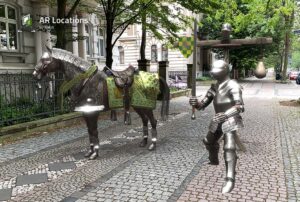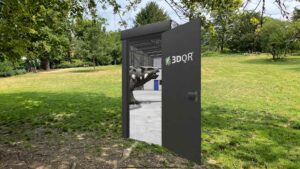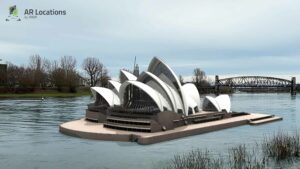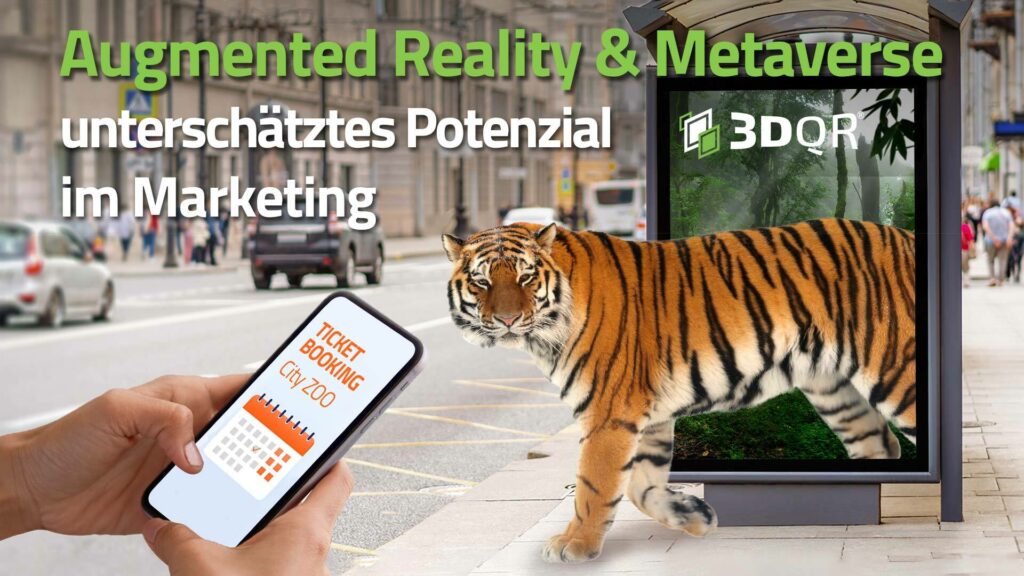Imagine walking into a zoo and being greeted by a life-sized animated penguin that educates you about the pollutants affecting its natural habitat. Welcome to the world of augmented reality in zoos, a technological revolution that’s changing the way we interact with and learn about wildlife. Pioneering this transformation is AR-Locations, a company that specializes in creating immersive AR experiences not just for zoos, but also for historical sites and museums.
By integrating life-size animated objects and scenes into real-world environments, AR-Locations offers a blend of education and entertainment that’s unparalleled. They provide customizable packages ranging from pre-made themes like ‘Dino City’ and ‘Christmas’ to tailored experiences that meet specific client needs. With the help of QR codes, these experiences come alive right on your smartphone, enhancing tourism and providing valuable educational content. Their innovative approach has already left an indelible impact at Magdeburg and Halle zoos, setting new benchmarks in interactive and educational experiences.
In this blog post, we’ll explore how AR-Locations is redefining the visitor experience, delve into specific case studies from Magdeburg and Halle, and look at the broader implications and future prospects of AR technology in wildlife conservation.
What is Augmented Reality?
Augmented Reality, or AR, is a technology that overlays digital elements—such as images, videos, or sounds—onto the real world. Unlike Virtual Reality, which creates a wholly artificial environment, AR adds to the existing setting by introducing these interactive elements. This is often facilitated through smartphone cameras or specialized AR glasses.
How does it work? Imagine scanning a QR code near a zoo exhibit with your smartphone. This action triggers a digital overlay that may present animated representations of animals, informational labels, or even interactive games. These digital components are geographically anchored, meaning they only appear when you are within a specified range, thanks to geofencing technology.
In zoos, the role of AR is not to replace the real-world experience but to enhance it. The technology serves to educate visitors about wildlife, create moments worth sharing on social media, and offer new ways to explore and understand the natural habitat of animals. It enriches the visitor experience while keeping the focus firmly on the real, living creatures that are the heart of any zoo.
The Role of AR in Zoos
In recent years, Augmented Reality has carved out a unique and invaluable role in zoos, providing a multifaceted enhancement to the traditional visitor experience. Unlike other sectors where AR is often primarily focused on gaming or retail, its application in zoos serves a more multi-dimensional purpose—educational, interactive, and shareable, all while complementing the awe of real animals.
Educational Aspects: One of the cornerstone applications of AR in zoos lies in education. Scanning QR codes near exhibits doesn’t just unlock an interactive feature; it opens the doors to a virtual classroom. Visitors can gain insights into the dietary habits of animals, the challenges they face in the wild due to climate change or human activities, and even take part in interactive quizzes that test their newfound knowledge. This dynamic form of learning adds an extra layer of depth to the zoo experience.
Shareable Moments: In our digital age, social media plays an integral role in how experiences are shared and remembered. AR technology takes this a step further by allowing visitors to capture truly unique moments. Imagine taking a selfie with an animated giraffe that playfully eats leaves from the top of your head, or recording a video where a 3D elephant explains the importance of wildlife conservation—all shareable at the touch of a button. These moments serve as both entertaining experiences and as powerful tools for spreading awareness about animal conservation.
Exploration: Beyond traditional maps and signage, AR provides a cutting-edge tool for exploration. Through geofencing technology, visitors can enjoy curated tours that guide them through the zoo, offering additional layers of information, interactive games, and quizzes at specific points of interest. This personalizes the zoo experience, making each visit unique and tailored to individual interests.
Complementing Real Animals: It’s crucial to remember that the stars of any zoo are the real, living creatures that inhabit it. Augmented Reality serves as a supplemental layer, enriching the observational experience by offering contextual information, interactive elements, and a touch of whimsy. It does not replace the intrinsic value and awe of observing animals in their habitats but adds a layer that makes each visit more insightful and memorable.
By serving these multiple functions, Augmented Reality doesn’t just enhance a visit to the zoo—it transforms it. It takes the conventional aspects of zoo-going—education, sharing, and exploration—and elevates them, creating a richer, more engaging experience that places both real-world animals and visitors at the center of a more interactive and informed universe.
AR-Locations: A Revolution in AR Experiences
When it comes to revolutionizing the Augmented Reality landscape, few companies come close to the impact of AR-Locations. Specializing in creating immersive and interactive AR experiences, this innovative firm has a broad range of applications, including historical sites and museums. However, their work in zoos, particularly in Magdeburg and Halle, is where their expertise truly shines.
Services and Offerings: AR-Locations provides a complete package for implementing AR experiences. This includes QR code stickers, 3D assets, and a platform for creating and managing the AR content. Their services aren’t limited to off-the-shelf solutions; they offer a wide array of pre-made packages like ‘Dino City’ and ‘Christmas,’ as well as custom experiences tailored to individual client needs.
Methodology: The process is elegantly simple yet profoundly impactful. Visitors scan QR codes with their smartphones, activating life-sized animated objects and scenes that blend seamlessly into the real-world environment. Furthermore, they employ geofencing technology to ensure that these experiences are location-specific, adding an extra layer of engagement and interactivity.
Unique Selling Points: What sets AR-Locations apart is their focus on creating experiences that are not only engaging but also educational. By clicking on elements within the AR scene, visitors can access a wealth of information, watch videos, or even participate in interactive quizzes. This makes every AR experience a learning opportunity, enriching the visitor’s understanding of wildlife and conservation issues.
Partnerships and Future Goals: AR-Locations is more than just a service provider; they’re a potential partner for any institution looking to bring their exhibits and spaces to life. Their goal is to change how people experience history and preserve cultural and natural heritage, making them a perfect fit for partnerships with museums, schools, and tourism boards.
In summary, AR-Locations is not just an AR company; they’re pioneers in creating meaningful, educational, and engaging experiences that have the power to transform public spaces, including zoos. Their work in Magdeburg and Halle serves as a testament to the limitless possibilities that AR offers in making educational spaces more interactive and impactful.
Case Studies
Magdeburg Zoo
Let’s start with Magdeburg Zoo, a pioneer in integrating Augmented Reality into its exhibits. Partnering with AR-Locations, the zoo has turned two of its most popular enclosures into interactive learning hubs.
Penguin Enclosure: One of the standout features is the AR experience near the penguin enclosure. By scanning a QR code, visitors activate an AR scene that reveals various pollutants that penguins face in their natural habitat. The experience is not just eye-opening but serves as a call to action, urging visitors to be more mindful of environmental conservation.
Lemur Enclosure: A different but equally impactful example is found at the lemur enclosure. Here, visitors can scan a QR code to initiate an AR experience that dramatically showcases the impact of deforestation and forest fires. Virtual trees are harvested and burned, illustrating the harsh realities these animals face. However, the experience doesn’t end on a note of despair; visitors can also virtually ‘plant’ new trees and watch them grow, highlighting the potential for positive human impact.
Halle Zoo
Moving on to Halle Zoo, where the focus of AR integration is slightly different but equally impactful.
Real-Size Animal Displays: At Halle Zoo, the primary goal is to provide visitors with a detailed impression of animals in their real size. By scanning QR codes near the exhibits, visitors can activate life-sized AR models of the animals, allowing for a closer look and a more detailed understanding of each species’ unique features.
In both Magdeburg and Halle zoos, AR-Locations has demonstrated the power of Augmented Reality to not only entertain but also educate and engage visitors in a meaningful way. Whether it’s understanding the impact of pollution on penguins or appreciating the majestic size of a tiger, Augmented Reality adds a layer of depth to the zoo experience that is hard to replicate.
The Future of Augmented Reality in Zoos
As we’ve explored through the case studies of Magdeburg and Halle zoos, the transformative power of Augmented Reality in enhancing the zoo experience is undeniable. However, this is just the beginning; the possibilities are virtually limitless.
Technological Advancements: With the rapid evolution of AR technology, zoos can look forward to even more sophisticated and engaging experiences. Imagine adaptive, AR-guided tours that respond in real-time to visitor preferences, or even real-time language translation features that make the zoo experience accessible to international visitors.
Ethical Considerations: One of the strengths of AR is its ability to engage visitors without compromising the well-being of the animals. The technology serves as a complementary tool that enhances visitor education while respecting animal habitats.
Potential Areas of Growth: Augmented Reality opens up unprecedented educational opportunities for zoos. From simulating extinct or endangered animals to AR-based games that educate and entertain, the sky is the limit.
Partnership Opportunities: Companies like AR-Locations are not just service providers but potential long-term partners that can help zoos achieve their educational and conservation goals. Their customizable solutions make it easier than ever for zoos to implement AR-based experiences that resonate with their unique visitor demographics.
In summary, the future for Augmented Reality in zoos is nothing short of exciting. As technology continues to advance, the opportunities for creating enriching, educational, and engaging zoo experiences are endless. Zoos looking to take their visitor experiences to the next level would do well to consider the myriad possibilities that AR technology, especially when partnered with pioneers like AR-Locations, can offer.
Conclusion
As we’ve journeyed through the world of Augmented Reality in zoos—from defining the technology to diving deep into real-world applications and glimpsing into the future—it’s clear that AR has the power to transform visitor experiences in remarkable ways.
Now, the ball is in your court.
Unlock Educational Potentials: Engage your visitors more deeply, providing dynamic educational experiences that make every visit memorable.
Create Shareable Moments: Offer unique, camera-ready opportunities that not only entertain but also educate, turning every visitor into an advocate for wildlife conservation.
Forge Meaningful Partnerships: Companies like AR-Locations are eager to collaborate with zoos, offering tailored solutions that align with your educational and conservation objectives.
Don’t just be a spectator in this evolving landscape—be a pioneer. If you’re looking to elevate your zoo to the next level, the time to explore the limitless possibilities of Augmented Reality is now. AR-Locations stands ready to partner with you in this exciting venture, redefining what a zoo experience can be for the 21st century.
Your next step in revolutionising zoo experiences awaits. Are you ready to take it?









